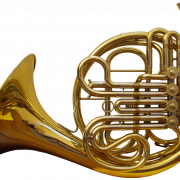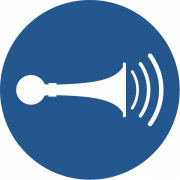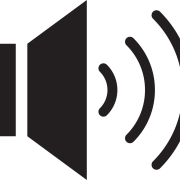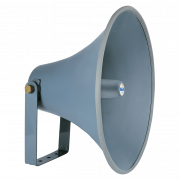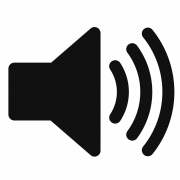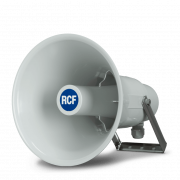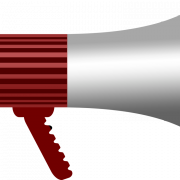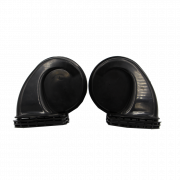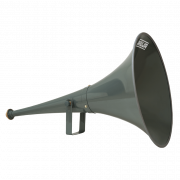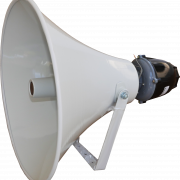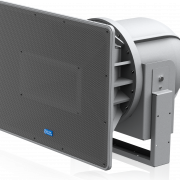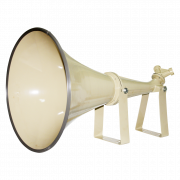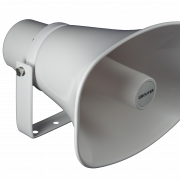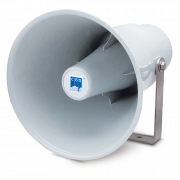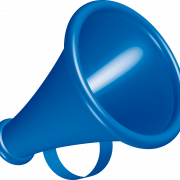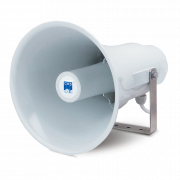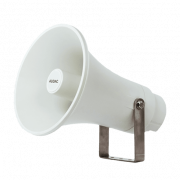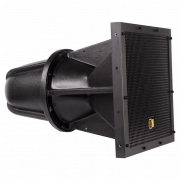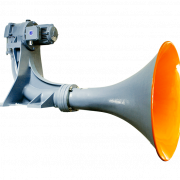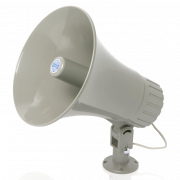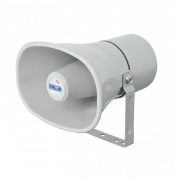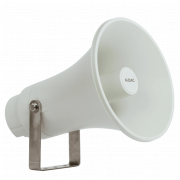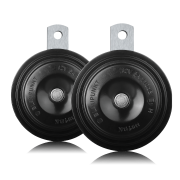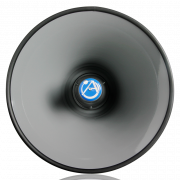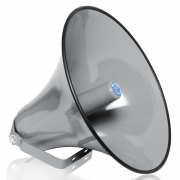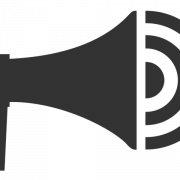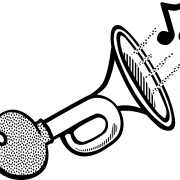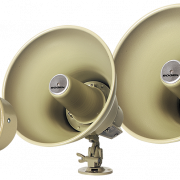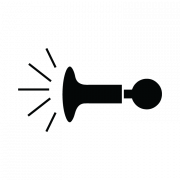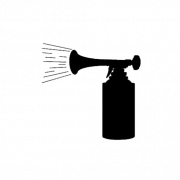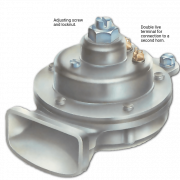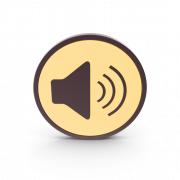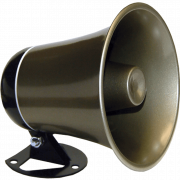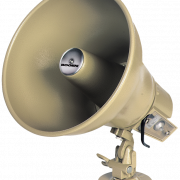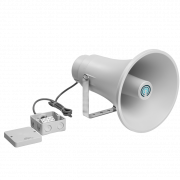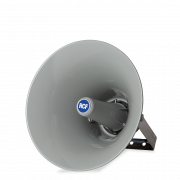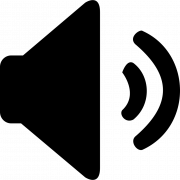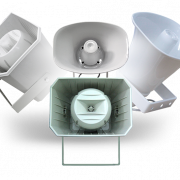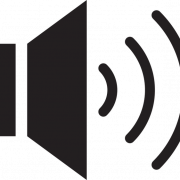Download top and best high-quality free Sound Horn PNG Transparent Images backgrounds available in various sizes. To view the full PNG size resolution click on any of the below image thumbnail.
License Info: Creative Commons 4.0 BY-NC
A loudspeaker or horn loudspeaker element that employs an acoustic horn to improve the overall efficiency of the driving element is known as a loudspeaker. A typical design includes a compression driver that generates sound waves by vibrating a tiny metal diaphragm with an electromagnet, a horn, and a flaring duct to transmit the sound waves to the open air. Another kind is a folded horn speaker, which consists of a woofer driver installed in a loudspeaker enclosure separated by internal partitions to produce a zigzag flaring duct that functions as a horn. The horn enhances the productivity of the connection between the speaker driver and the air. The horn functions as an “acoustic transformer,” matching the impedance of the relatively dense diaphragm material to the less thick air. As a result, a given driver’s acoustic output power increases.
The “throat” is the narrow section of the horn closest to the driver, while the “mouth” is the vast part furthest away from the driver. The shape and flare of the mouth influence the horn’s angular coverage (radiation pattern). The radiation pattern of horn speakers changes with frequency; high-frequency sound tends to be produced in narrow beams with poor off-axis performance. With Don Keele’s invention of the “constant directivity” horn in 1975, significant advancements have been achieved.
The primary benefit of horn loudspeakers is that they are more efficient; they can generally deliver three times (10 dB) more sound power from a given amplifier output than cone speakers. As a result, horns are commonly used in prominent venues such as theaters, auditoriums, and sports stadiums in public address systems, megaphones, and sound systems. They have the drawback of having a more uneven frequency response due to resonance peaks, and horns have a cutoff frequency beyond which their response goes down. (The wavelength corresponding to the radius of the horn mouth corresponds to the cutoff frequency.) Horn speakers must be pretty big and heavy to produce an acceptable bass response. Therefore they are more commonly employed for midrange and high frequencies. Horn speakers were the first practical loudspeakers introduced around the beginning of the twentieth century. The usage of horn speakers in high-fidelity audio systems has diminished in recent decades due to the advent of cone loudspeakers with a flatter frequency response and the availability of affordable amplifier power.
Huge pressure fluctuations with a small displacement area are converted to low-pressure changes with a large displacement area by an acoustic horn and vice versa. It accomplishes this by gradually increasing the horn’s cross-sectional area, which is frequently exponential. The throat’s narrow cross-sectional area inhibits airflow, resulting in a high acoustic impedance for the driver. This allows the driver to build up a lot of pressure for a small amount of displacement. As a result, sound waves reaching the throat have high pressure but a small displacement. The horn’s tapering form allows sound waves to progressively decompress and expand in displacement until they reach the mouth, where they are low in pressure but high in exile.
A contemporary horn functions in the same way, with an electrically powered dynamic or piezoelectric loudspeaker replacing the mechanically stimulated diaphragm.
Download Sound Horn PNG images transparent gallery.
- Sound Horn PNG Picture
Resolution: 880 × 626
Size: 567 KB
Image Format: .png
Download
- Vector Sound Horn PNG Free Download
Resolution: 1200 × 1200
Size: 62 KB
Image Format: .png
Download
- Sound Horn Silhouette PNG File
Resolution: 1280 × 1125
Size: 79 KB
Image Format: .png
Download
- Sound Horn PNG Free Image
Resolution: 800 × 800
Size: 181 KB
Image Format: .png
Download
- Sound Horn Silhouette PNG HD Image
Resolution: 1200 × 1200
Size: 30 KB
Image Format: .png
Download
- Sound Horn Silhouette PNG Pic
Resolution: 1024 × 870
Size: 31 KB
Image Format: .png
Download
- Sound Horn Silhouette PNG Image
Resolution: 800 × 611
Size: 16 KB
Image Format: .png
Download
- Sound Horn Megaphone PNG File
Resolution: 768 × 768
Size: 92 KB
Image Format: .png
Download
- Sound Horn PNG File
Resolution: 1081 × 750
Size: 63 KB
Image Format: .png
Download
- Sound Horn PNG HD Image
Resolution: 1000 × 1000
Size: 391 KB
Image Format: .png
Download
- Sound Horn PNG Pic
Resolution: 800 × 800
Size: 69 KB
Image Format: .png
Download
- Sound Horn Megaphone PNG
Resolution: 2191 × 2324
Size: 505 KB
Image Format: .png
Download
- Sound Horn
Resolution: 1845 × 1722
Size: 854 KB
Image Format: .png
Download
- Sound Horn Megaphone
Resolution: 1000 × 1000
Size: 521 KB
Image Format: .png
Download
- Sound Horn PNG Download Image
Resolution: 3120 × 2344
Size: 373 KB
Image Format: .png
Download
- Sound Horn Megaphone PNG Pic
Resolution: 1000 × 1000
Size: 686 KB
Image Format: .png
Download
- Sound Horn PNG High Quality Image
Resolution: 1200 × 1116
Size: 480 KB
Image Format: .png
Download
- Sound Horn Megaphone PNG High Quality Image
Resolution: 1000 × 1000
Size: 547 KB
Image Format: .png
Download
- Sound Horn Megaphone PNG Images
Resolution: 800 × 458
Size: 31 KB
Image Format: .png
Download
- Sound Horn PNG Images
Resolution: 1024 × 1024
Size: 251 KB
Image Format: .png
Download
- Sound Horn Megaphone PNG Image File
Resolution: 1000 × 667
Size: 582 KB
Image Format: .png
Download
- Sound Horn Megaphone PNG Photo
Resolution: 800 × 800
Size: 500 KB
Image Format: .png
Download
- Sound Horn PNG Image File
Resolution: 800 × 800
Size: 229 KB
Image Format: .png
Download
- Sound Horn Megaphone PNG Image HD
Resolution: 1024 × 1024
Size: 128 KB
Image Format: .png
Download
- Sound Horn PNG Photo
Resolution: 1080 × 1080
Size: 717 KB
Image Format: .png
Download
- Sound Horn Silhouette
Resolution: 980 × 990
Size: 49 KB
Image Format: .png
Download
- Sound Horn Megaphone PNG HD Image
Resolution: 1024 × 1024
Size: 19 KB
Image Format: .png
Download
- Sound Horn PNG File Download Free
Resolution: 800 × 800
Size: 845 KB
Image Format: .png
Download
- Sound Horn PNG Image HD
Resolution: 800 × 800
Size: 645 KB
Image Format: .png
Download
- Sound Horn Megaphone PNG File Download Free
Resolution: 960 × 679
Size: 336 KB
Image Format: .png
Download
- Sound Horn Megaphone PNG Transparent HD Photo
Resolution: 1440 × 1464
Size: 550 KB
Image Format: .png
Download
- Vector Sound Horn
Resolution: 960 × 480
Size: 48 KB
Image Format: .png
Download
- Sound Horn PNG Transparent HD Photo
Resolution: 847 × 720
Size: 127 KB
Image Format: .png
Download
- Sound Horn Megaphone PNG Download Image
Resolution: 2202 × 2104
Size: 117 KB
Image Format: .png
Download
- Sound Horn Megaphone PNG Image
Resolution: 878 × 496
Size: 586 KB
Image Format: .png
Download
- Sound Horn Silhouette PNG
Resolution: 750 × 750
Size: 4 KB
Image Format: .png
Download
- Sound Horn Silhouette Transparent
Resolution: 934 × 534
Size: 32 KB
Image Format: .png
Download
- Vector Sound Horn PNG
Resolution: 1920 × 1920
Size: 12 KB
Image Format: .png
Download
- Sound Horn PNG
Resolution: 708 × 693
Size: 107 KB
Image Format: .png
Download
- Vector Sound Horn PNG Image
Resolution: 1025 × 1038
Size: 260 KB
Image Format: .png
Download
- Sound Horn Megaphone Transparent
Resolution: 1702 × 1884
Size: 607 KB
Image Format: .png
Download
- Sound Horn PNG Image
Resolution: 1000 × 1000
Size: 243 KB
Image Format: .png
Download
- Sound Horn Megaphone PNG Clipart
Resolution: 1000 × 1000
Size: 205 KB
Image Format: .png
Download
- Sound Horn Megaphone PNG Free Download
Resolution: 646 × 766
Size: 553 KB
Image Format: .png
Download
- Sound Horn Megaphone PNG Picture
Resolution: 901 × 901
Size: 165 KB
Image Format: .png
Download
- Sound Horn Silhouette PNG Clipart
Resolution: 934 × 534
Size: 56 KB
Image Format: .png
Download
- Sound Horn Transparent
Resolution: 768 × 768
Size: 351 KB
Image Format: .png
Download
- Vector Sound Horn Transparent
Resolution: 1920 × 1920
Size: 15 KB
Image Format: .png
Download
- Sound Horn PNG Clipart
Resolution: 1280 × 858
Size: 122 KB
Image Format: .png
Download
- Vector Sound Horn PNG Clipart
Resolution: 1920 × 1920
Size: 16 KB
Image Format: .png
Download
- Sound Horn Megaphone PNG Free Image
Resolution: 1824 × 1779
Size: 500 KB
Image Format: .png
Download
- Sound Horn Silhouette PNG Free Download
Resolution: 981 × 380
Size: 15 KB
Image Format: .png
Download
- Sound Horn Silhouette PNG Picture
Resolution: 980 × 980
Size: 22 KB
Image Format: .png
Download
- Sound Horn PNG Free Download
Resolution: 687 × 529
Size: 335 KB
Image Format: .png
Download
- Sound Horn Silhouette PNG Free Image
Resolution: 640 × 562
Size: 36 KB
Image Format: .png
Download
